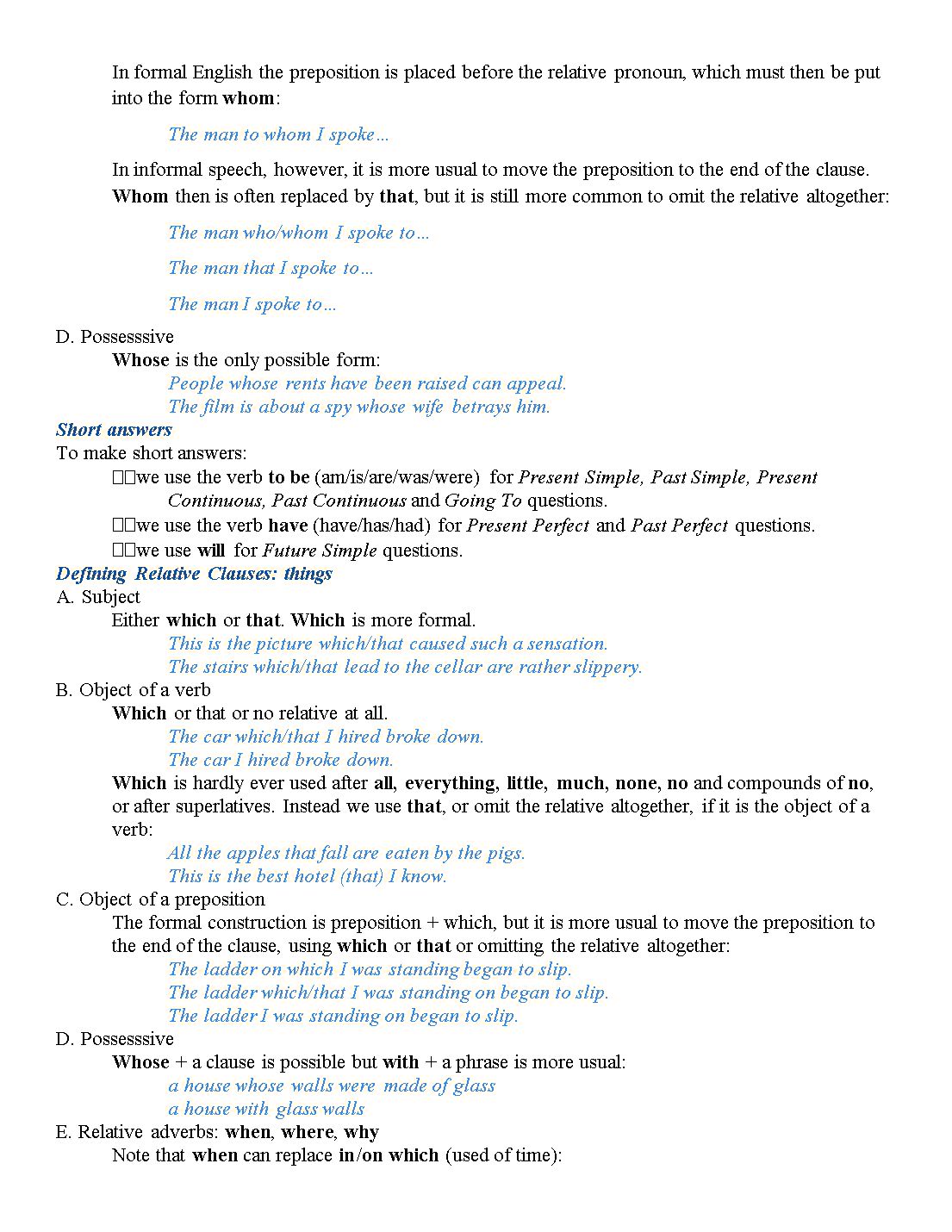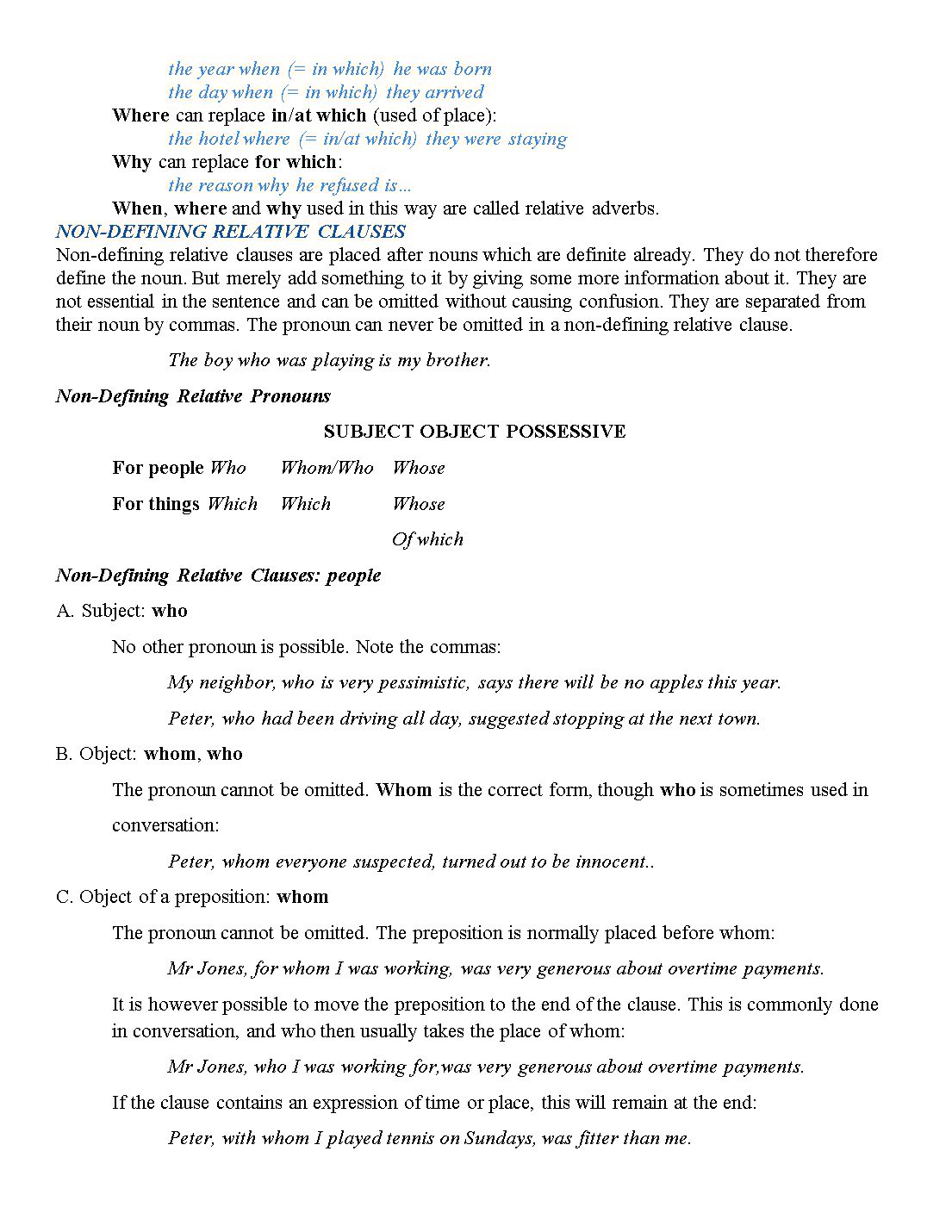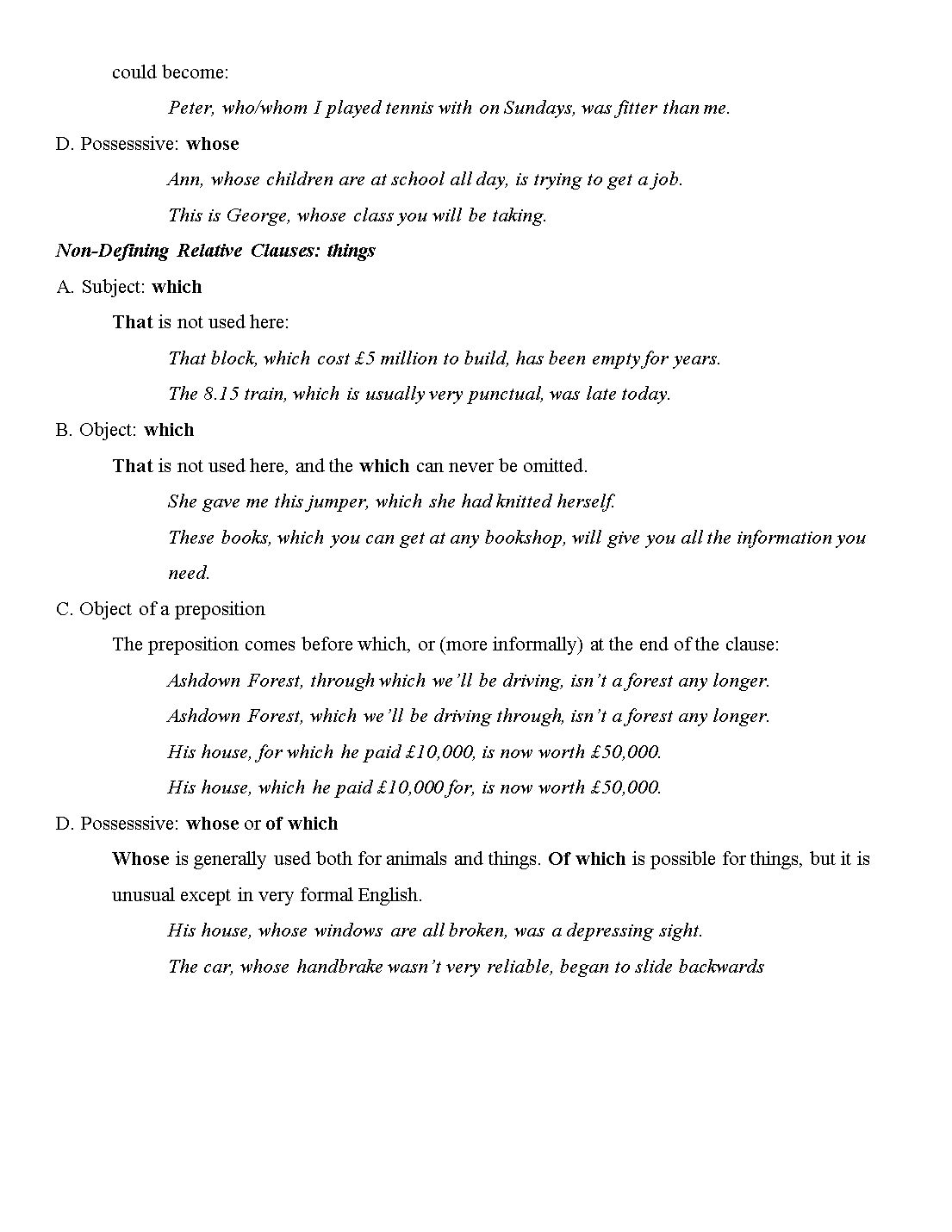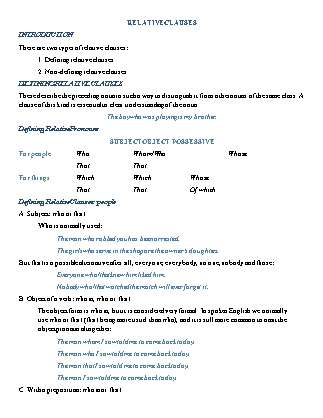Lý thuyết và bài tập về Mệnh đề quan hệ trong Tiếng Anh - Bùi Thanh Văn
INTRODUCTION
There are two types of relative clauses:
1. Defining relative clauses
2. Non-defining relative clauses
DEFINING RELATIVE CLAUSES
These describe the preceding noun in such a way to distinguish it from other nouns of the same class. A clause of this kind is essential to clear understanding of the noun.
The boy who was playing is my brother.
Defining Relative Pronouns
SUBJECT OBJECT POSSESSIVE
For people Who Whom/Who Whose
That That
For things Which Which Whose
That That Of which
Defining Relative Clauses: people
A. Subject: who or that
Who is normally used:
The man who robbed you has been arrested.
The girls who serve in the shop are the owner’s daughters.
But that is a possible alternative after all, everyone, everybody, no one, nobody and those:
Everyone who/that knew him liked him.
Nobody who/that watched the match will ever forget it.
B. Object of a verb: whom, who or that
The object form is whom, but it is considered very formal. In spoken English we normally use who or that (that being more usual than who), and it is still more common to omit the object pronoun altogether:
The man whom I saw told me to come back today.
The man who I saw told me to come back today.
The man that I saw told me to come back today.
The man I saw told me to come back today.

Trang 1

Trang 2

Trang 3

Trang 4
Tóm tắt nội dung tài liệu: Lý thuyết và bài tập về Mệnh đề quan hệ trong Tiếng Anh - Bùi Thanh Văn

RELATIVE CLAUSES INTRODUCTION There are two types of relative clauses: 1. Defining relative clauses 2. Non-defining relative clauses DEFINING RELATIVE CLAUSES These describe the preceding noun in such a way to distinguish it from other nouns of the same class. A clause of this kind is essential to clear understanding of the noun. The boy who was playing is my brother. Defining Relative Pronouns SUBJECT OBJECT POSSESSIVE For people Who Whom/Who Whose That That For things Which Which Whose That That Of which Defining Relative Clauses: people A. Subject: who or that Who is normally used: The man who robbed you has been arrested. The girls who serve in the shop are the owner’s daughters. But that is a possible alternative after all, everyone, everybody, no one, nobody and those: Everyone who/that knew him liked him. Nobody who/that watched the match will ever forget it. B. Object of a verb: whom, who or that The object form is whom, but it is considered very formal. In spoken English we normally use who or that (that being more usual than who), and it is still more common to omit the object pronoun altogether: The man whom I saw told me to come back today. The man who I saw told me to come back today. The man that I saw told me to come back today. The man I saw told me to come back today. C. With a preposition: whom or that In formal English the preposition is placed before the relative pronoun, which must then be put into the form whom: The man to whom I spoke In informal speech, however, it is more usual to move the preposition to the end of the clause. Whom then is often replaced by that, but it is still more common to omit the relative altogether: The man who/whom I spoke to The man that I spoke to The man I spoke to D. Possesssive Whose is the only possible form: People whose rents have been raised can appeal. The film is about a spy whose wife betrays him. Short answers To make short answers: we use the verb to be (am/is/are/was/were) for Present Simple, Past Simple, Present Continuous, Past Continuous and Going To questions. we use the verb have (have/has/had) for Present Perfect and Past Perfect questions. we use will for Future Simple questions. Defining Relative Clauses: things A. Subject Either which or that. Which is more formal. This is the picture which/that caused such a sensation. The stairs which/that lead to the cellar are rather slippery. B. Object of a verb Which or that or no relative at all. The car which/that I hired broke down. The car I hired broke down. Which is hardly ever used after all, everything, little, much, none, no and compounds of no, or after superlatives. Instead we use that, or omit the relative altogether, if it is the object of a verb: All the apples that fall are eaten by the pigs. This is the best hotel (that) I know. C. Object of a preposition The formal construction is preposition + which, but it is more usual to move the preposition to the end of the clause, using which or that or omitting the relative altogether: The ladder on which I was standing began to slip. The ladder which/that I was standing on began to slip. The ladder I was standing on began to slip. D. Possesssive Whose + a clause is possible but with + a phrase is more usual: a house whose walls were made of glass a house with glass walls E. Relative adverbs: when, where, why Note that when can replace in/on which (used of time): the year when (= in which) he was born the day when (= in which) they arrived Where can replace in/at which (used of place): the hotel where (= in/at which) they were staying Why can replace for which: the reason why he refused is When, where and why used in this way are called relative adverbs. NON-DEFINING RELATIVE CLAUSES Non-defining relative clauses are placed after nouns which are definite already. They do not therefore define the noun. But merely add something to it by giving some more information about it. They are not essential in the sentence and can be omitted without causing confusion. They are separated from their noun by commas. The pronoun can never be omitted in a non-defining relative clause. The boy who was playing is my brother. Non-Defining Relative Pronouns SUBJECT OBJECT POSSESSIVE For people Who Whom/Who Whose For things Which Which Whose Of which Non-Defining Relative Clauses: people A. Subject: who No other pronoun is possible. Note the commas: My neighbor, who is very pessimistic, says there will be no apples this year. Peter, who had been driving all day, suggested stopping at the next town. B. Object: whom, who The pronoun cannot be omitted. Whom is the correct form, though who is sometimes used in conversation: Peter, whom everyone suspected, turned out to be innocent.. C. Object of a preposition: whom The pronoun cannot be omitted. The preposition is normally placed before whom: Mr Jones, for whom I was working, was very generous about overtime payments. It is however possible to move the preposition to the end of the clause. This is commonly done in conversation, and who then usually takes the place of whom: Mr Jones, who I was working for,was very generous about overtime payments. If the clause contains an expression of time or place, this will remain at the end: Peter, with whom I played tennis on Sundays, was fitter than me. could become: Peter, who/whom I played tennis with on Sundays, was fitter than me. D. Possesssive: whose Ann, whose children are at school all day, is trying to get a job. This is George, whose class you will be taking. Non-Defining Relative Clauses: things A. Subject: which That is not used here: That block, which cost £5 million to build, has been empty for years. The 8.15 train, which is usually very punctual, was late today. B. Object: which That is not used here, and the which can never be omitted. She gave me this jumper, which she had knitted herself. These books, which you can get at any bookshop, will give you all the information you need. C. Object of a preposition The preposition comes before which, or (more informally) at the end of the clause: Ashdown Forest, through which we’ll be driving, isn’t a forest any longer. Ashdown Forest, which we’ll be driving through, isn’t a forest any longer. His house, for which he paid £10,000, is now worth £50,000. His house, which he paid £10,000 for, is now worth £50,000. D. Possesssive: whose or of which Whose is generally used both for animals and things. Of which is possible for things, but it is unusual except in very formal English. His house, whose windows are all broken, was a depressing sight. The car, whose handbrake wasn’t very reliable, began to slide backwards
File đính kèm:
 ly_thuyet_va_bai_tap_ve_menh_de_quan_he_trong_tieng_anh_bui.docx
ly_thuyet_va_bai_tap_ve_menh_de_quan_he_trong_tieng_anh_bui.docx

